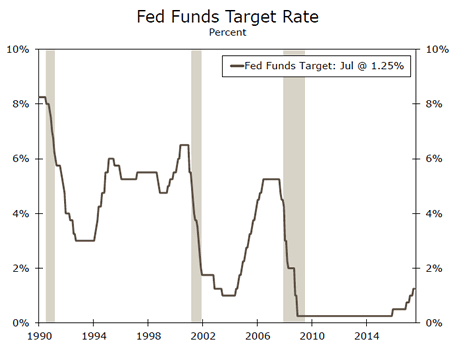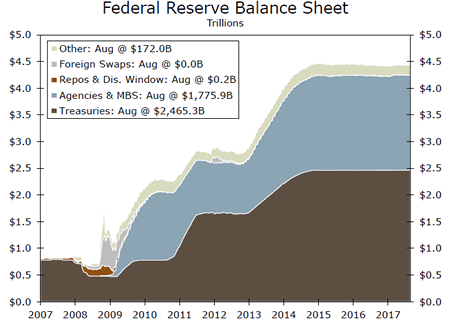U.S. Review
That’s Great it Starts With an Earthquake
- The economy took a backseat to the simultaneous approach of three hurricanes in the Atlantic basin and a magnitude 8.1 earthquake off the coast of Mexico. The influence of the storms is starting to soak into the economic data.
- Perhaps the most impactful economic news of the week came from the (pre-storm) factory orders report. While not typically a headlining economic indicator, it offered an indication of stronger business spending in July. Later in the week we learned that the ISM non-manufacturing index also improved, suggesting the momentum carried into August.
Here Comes the Story of the Hurricane(s)
Before the waters have fully receded in Houston, national attention has turned to the approach of Hurricane Irma barreling toward Florida and the southeastern United States. Our primary concern of course is for the people in the Caribbean who are still coming to grips with the devastation and that of our neighbors in Irma’s path who are still in harm’s way. In a recent special report "Impact of Hurricane Harvey" we consider the economic implications of the still undetermined damage in Houston.
The first hard-data reflection of the storms was manifested in this week’s report on first-time claims for unemployment insurance. Jobless claims jumped to 298K from 236K in the prior week. The Labor Department reported an unadjusted increase of roughly 52K claims in Texas. The top chart show initial claims for the past 20 years and you can see the spike in 2005 related to Hurricane Katrina (circled in red), and the subsequent drop-off in claims that followed. The most important point though is that claims were only briefly affected at that time.
Using Katrina as a proxy, we can reasonably expect claims to continue to rise in coming weeks. That said, it is too early to tell yet what impact the storms will have on other measures of economic growth, but we will be monitoring the situation and will provide some thoughts where we can offer analysis rather than conjecture. In the meantime, we can unpack what this week’s economic indicators tell us about the current condition of the expansion, starting with the factory orders report.
Shipments of core capital goods orders increased 1.2 percent in July, lifting the 3-month annualized growth rate to 5.4 percent. This is consistent with our forecast for gradual firming in equipment investment in the third quarter.
In a positive sign for future spending prospects, core capital goods orders also increased in July, growing 1.0 percent, which puts the 3-month annualized rate for that series at 5.1 percent. After having been a drag on growth in 2015 and 2016 when low oil and commodity prices acted as a damper on spending plans, equipment outlays have been gradually firming and added to topline growth for three-straight quarters.
Speed it up a Notch
As the bottom chart shows, during the 2015-2016 period, activity in the service sector handily outpaced activity in the factory sector. Both measures are in expansion territory today and we learned this week that the service-sector measure improved to 55.3 from 53.9 previously.
In a bit of role-reversal, the past few months have been characterized by activity in the manufacturing sector outpacing that of the service sector. ISM non-manufacturing tends to be a useful proxy of future core retail sales growth.
On that basis, our forecast for firming equipment spending in the second half and a softening in the pace of retail sales growth is consistent with what the survey data are signaling at present.

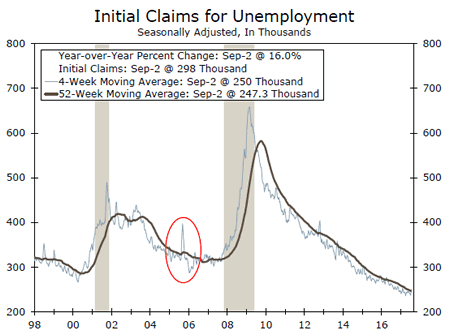
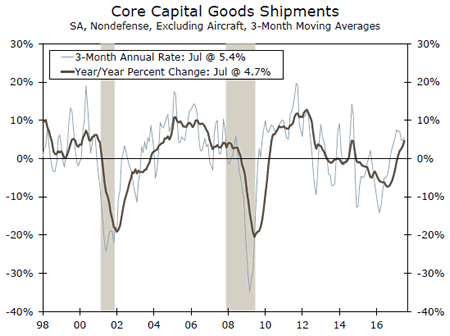
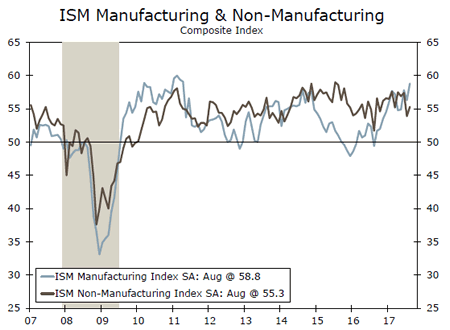
U.S. Outlook
CPI • Thursday
Consumer price growth remained subdued in July. Both headline and core CPI rose 0.1 percent on the month and 1.7 percent over the year. July’s monthly figure was an improvement from the previous two months, however, as prices declined in May and were flat in June. Energy prices were a drag on the headline over the past three months, which we can expect to reverse in coming months as gas prices reflect the damage from Hurricane Harvey on the heart of the domestic energy sector. Retail gasoline prices surged around September 1, so August headline CPI is likely in the clear.
Looking to the trend, we expect below-target inflation to continue into next year. We expect only two rate increases by the FOMC in 2018—not the three the FOMC has currently projected, as the outlook for core inflation remains modest.
Previous: 0.1% Wells Fargo: 0.3% Consensus: 0.3% (Month-Over-Month)
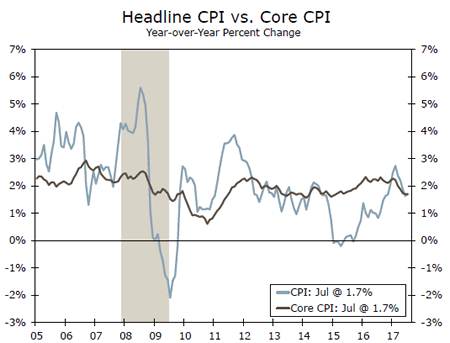
Industrial Production • Friday
Industrial output rose 0.2 percent in July, though the increase was entirely due to mining and utilities output. Manufacturing output has been up one month and down the next, with July falling in the latter, down 0.1 percent. The sawtooth pattern is consistent with our forecast for continued modest, but steady growth. Taking a longer view, manufacturing output is up 0.8 percent, year to date.
Industrial production data are likely to be affected by Hurricane Harvey in coming months, as the storm knocked out utilities and mining operations. The shutdown of petrochemical plants and other key nodes in the domestic supply chain may extend the impact to longer than just one month, though IP recovered rather quickly following Katrina in 2005. Hurricane Irma may also have repercussions on manufacturing production operations that lay in its path this weekend, though to a smaller extent as it is not currently aiming at the heart of U.S. oil production.
Previous: 0.2% Wells Fargo: 0.2% Consensus: 0.1% (Month-Over-Month)
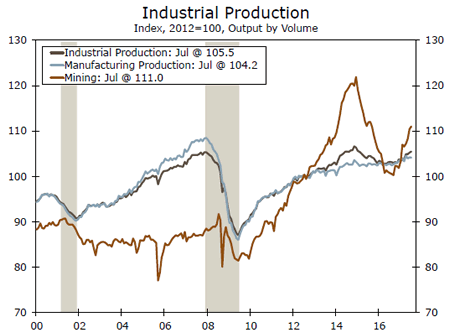
Retail Sales • Friday
July marked a strong start to the third quarter for retail sales, which rose 0.6 percent while June’s decline was revised to a gain. Personal consumption expenditures in Q2 GDP also received an upward revision, pushing growth to 3.0 percent. Revisions show the domestic consumer was on solid footing in Q2 and had good momentum at the start of Q3. The strong showing for control group sales, which enters into the GDP calculation, gives more credence to our call for a strong consumer for the rest of the year.
Retail sales are also a series likely impacted by Harvey and Irma, though it is difficult to predict whether Hurricane Harvey will show in next week’s advanced estimate for August. The impact will likely be more apparent in the revisions. September will also likely be skewed by both Harvey and Irma, and Florida’s missed tourism dollars may weigh on year-over-year sales in subsequent months.
Previous: 0.6% Wells Fargo: 0.1% Consensus: 0.1% (Month-Over-Month)
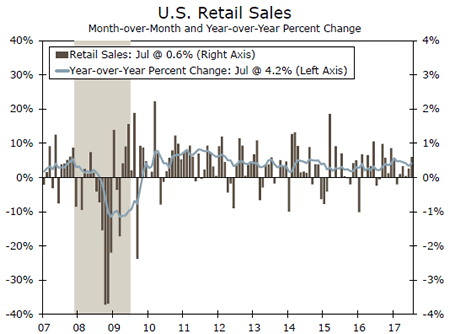
Global Review
Strong Growth Leads Bank of Canada to Hike Rates
- The Bank of Canada surprised many analysts this week by announcing its second 25 bps rate hike since July. The Bank cited strong economic growth as a reason for hiking rates. The Canadian dollar rose to a two-year high against the U.S. dollar this week.
ECB Remains on Hold, For Now
- The ECB did not make any changes to its policy stance this week. However, the expansion in the Eurozone is becoming increasingly self-sustaining, and we look for the Governing Council to announce a further reduction in the monthly pace of its bond purchases at its next policy meeting on October 26.
Strong Growth Leads Bank of Canada to Hike Rates
The Bank of Canada (BoC) surprised many analysts this week by hiking its main policy rate by 25 bps, the second rate hike since mid-July (see graph on front page). The rate hike brings the main policy rate back to 1.00 percent, the level that prevailed in January 2015 before the Canadian economy slid into a mild recession. In announcing the rate hike, the BoC said that "recent economic data have been stronger than expected" and that growth "is becoming more broad-based and self-sustaining." That said, the BoC noted that the outlook is subject to a number of risks and that future policy moves "are not predetermined."
The Canadian dollar, which is up more than 10 percent vis-à-vis the U.S. dollar since the beginning of the year, rallied in the immediate aftermath of the surprise rate hike and rose to a twoyear high versus the greenback (top chart). We look for the BoC to hike rates twice in 2018. Our currency strategy group expects the loonie will continue to trend higher versus the greenback going forward, albeit not as rapidly as in recent months.
ECB Remains on Hold, For Now
The European Central Bank also held a policy meeting this week. Unlike the BoC, the ECB Governing Council decided to keep its policy rates on hold, which was widely expected. The Governing Council also decided to keep the flow of its quantitative easing (QE) program unchanged at €60 billion per month, which was also widely expected.
In the policy statement that followed the meeting, the Governing Council acknowledged that the economic expansion in the euro area "continues to be solid and broad-based across countries and sectors." Indeed, the year-over-year rate of GDP growth in Q2, which was originally reported as 2.2 percent, was revised up this week to a six-year high of 2.3 percent.
There is not much "hard" data out of the third quarter yet, but the purchasing managers’ indices remain well above the demarcation line separating expansion from contraction. Industrial production (IP) in Germany was flat in July relative to the previous month, but the year-over-year rate of growth remained buoyant at 4.0 percent (bottom chart). French IP rose 0.5 percent in July relative to the previous month, bringing the year-over-year growth rate up to a two-year high of 3.7 percent.
The ECB has had a QE program in place for more than two years, which has led to a doubling in the size of its balance sheet over that period (middle chart). In March, the Governing Council announced that it would dial back its monthly purchase rate of bonds from €80 billion per month to €60 billion per month, where it has subsequently been maintained. With the expansion becoming increasingly self-sustaining, we look for the Governing Council to announce a further reduction in its monthly purchase rate at its October 26 meeting. By the middle of next year, we expect that the ECB will cease buying bonds altogether. However, the Governing Council does not appear to be in any hurry to hike rates. With CPI inflation well below 2 percent at present, we look for the ECB to keep rates on hold until the end of 2018.
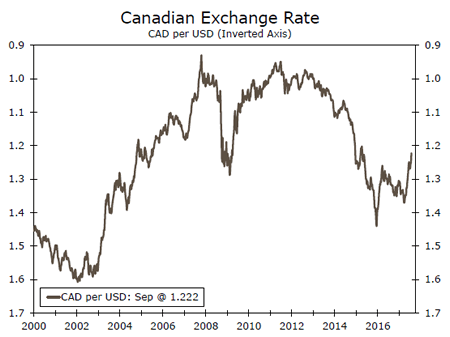
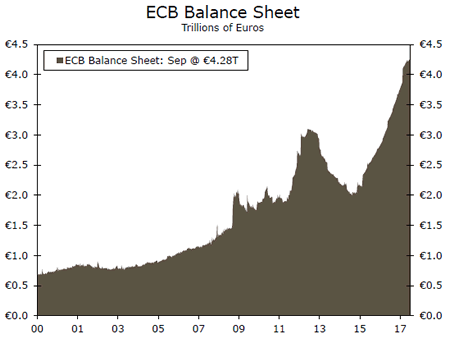
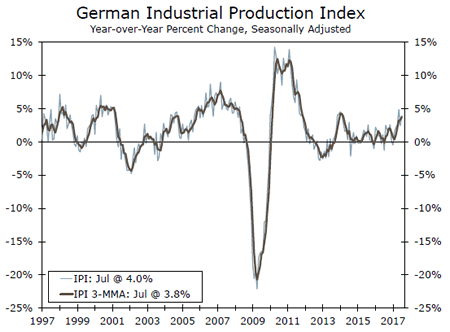
Global Outlook
Eurozone Industrial Prod. • Wednesday
The Eurozone grew at a relatively healthy clip in Q2 2017, up 0.6 percent seasonally adjusted (not annualized) and by an upwardly revised 2.3 percent year-over-year rate. Furthermore, we have seen some forward momentum on the Markit manufacturing PMI, which printed 57.4 in August, matching the highest reading for the series recorded in June of this year. At the same time the ECB kept monetary policy unchanged (read more on this on our Global Review section on the previous page).
With this information in the background, the industrial production index declined 0.6 percent in June after a very strong month in May, up 1.2 percent. Thus, markets will be anticipating if the industrial production index recovers in July to see if the economy kept its momentum at the start of the third quarter.
Previous: -0.6% Consensus: 0.0% (Month-Over-Month)
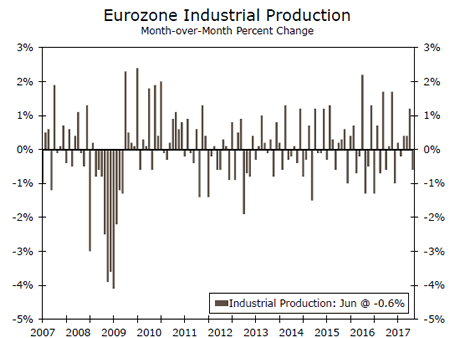
China Industrial Prod. • Wednesday
The year-over-year uptick in the Chinese industrial production index compared to last year has not gone unnoticed by the rest of the global economy with industrial production and export growth improving across the globe. Thus, when the Chinese industrial production index for August hits the airwaves on Wednesday it could impact markets. Consensus expectations call for the index to have improved from 6.4 percent for the year ending in July to 6.6 percent year-on-year in August, a marginal increase but positive nonetheless. At the same time, consensus expects the index to have increased 6.8 percent on a year-to-date basis in August.
Also on Wednesday we get Chinese retail sales for August and markets are also looking for a slight increase for the year-over-year measure, from 10.4 percent in July to 10.5 percent in August.
Previous: 6.4% Consensus: 6.8% (Year-Over-Year)
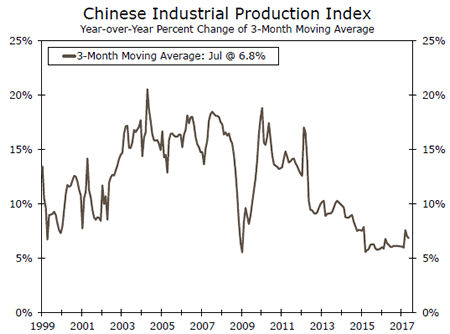
Brazil Economic Activity Index • Thursday
Although the Brazilian political corruption crisis continues to amaze friends and foes alike almost on a daily basis, the Brazilian economy seems to have finally detached from the travails of its political malaise and is primed for a continuation of growth. Of course, the political risks could still potentially, once again, derail the current recovery. However, the recovery is sustained by the economic collapse of the last several years. That is, economic numbers are coming from such a low base that it will be difficult for the economy not to continue to show improvement.
Case in point will be the release on Thursday of the monthly economic activity index for July. Although the index has not been consistently positive on a month-on-month or even on year-over year basis, the economic activity index has improved considerably compared to the last several years.
Previous: -0.6% (Year-Over-Year)

Point of View
Interest Rate Watch
Slower Reflation, Slower Tightening?
The FOMC is likely to lay out a more gradual path for inflation in its next set of projections, due after the committee wraps up its Sep. 19-20 meeting.
As of its June meeting, FOMC members expected headline PCE inflation to reach 1.6 percent by year end. That continues to look reasonable due to the jump in gasoline prices expected for September, but expectations for core inflation will likely be revised lower. In June, the median forecast for core inflation was 1.7 percent. To be achieved, monthly inflation readings for the remainder of the year would need to average 0.2 percent a month—twice the pace of gains so far this year. That could be a tall order, especially since core inflation has tended to post smaller gains in H2.
Reaching 2.0 percent by the end of 2018, the current median FOMC estimate, also looks tougher. While recent base effects will not need to be factored in to officials’ 2018 estimates, the soft patch in core inflation since the Spring has some Fed officials questioning the traditional emphasis on resource slack. At the July FOMC meeting, participants discussed the efficacy of such framework. This week Fed Governor Lael Brainard highlighted the disconnect between inflation and an economy operating near full employment, casting doubt on resource utilization as a reason for low inflation.
As Fed officials go through a rethink, we expect to see a shallower path of inflation laid out. While resource utilization still plays an important role in inflation, the weakness of recent months have highlighted it is not the only driver. Expectations, influenced by the recent trend in inflation, remain key and are still at historically low levels. As a result, it may be harder for services inflation to break out of its current trend channel despite further tightening in the labor market. Core goods prices should get a boost from a weaker dollar and rising inflation abroad. The lift, however, will be limited by declining prices for autos. The question for Fed officials in the coming months will be whether the slowdown is significant enough to warrant a slower pace of future rate hikes.
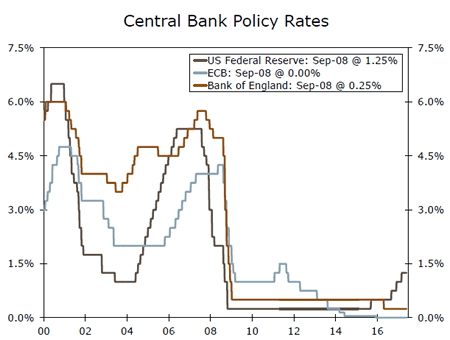
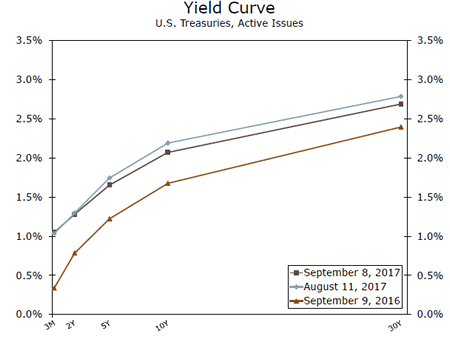
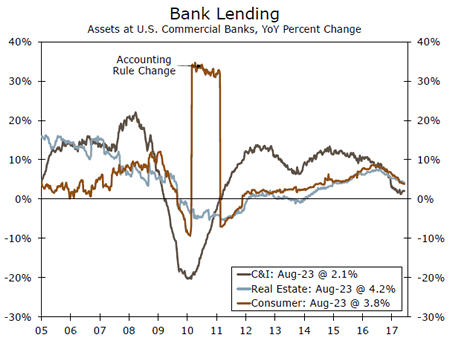
Credit Market Insights
The Beige Book Credit Outlook
The Fed’s most recent Beige Book conveyed healthy economic conditions throughout the twelve Federal Reserve Districts. Credit conditions appear to be broadly stable throughout the United States. In its August 2017 report the Fed noted, "business and consumer loan demand grew at a modest pace in most districts, with a number of banks reporting rising competition from both other banks and non-bank lenders."
There were modest changes in loan demand across the districts. Richmond and Chicago reported slight growth in loan demand, and both the Philadelphia and Dallas districts reported a faster pace of demand compared to the previous reporting period. There was steady loan demand reported in New York, Cleveland, and Kansas city.
Modest loan growth has been attributed to an increase in competition among banks and non-banking institutions, and the uncertain political climate. The limited supply of homes for sale has caused mortgage activity to slow in some districts. Several districts also reported concerns regarding the decline in auto lending, attributed to a slowdown in auto demand. Delinquency rates appear low to moderate across the districts. Loan portfolios were considered healthy, with no significant signs of concern.
The modest growth depicted in the Beige Book has left sentiments about future business activity and loan demand largely positive.
Topic of the Week
Fischer to Leave Fed in October
Stanley Fischer, who has served as the Vice-Chairman of the Federal Reserve Board since May 2014, announced this week that he would be resigning "on or around October 13." Before joining the Fed, Fischer did stints as a Professor of Economics at MIT, Chief Economist of the World Bank, Deputy Managing Director of the IMF, and Governor of the Bank of Israel. He is widely respected due to his deep knowledge of economics and monetary policymaking.
There currently are only four members on the sevenmember Board of Governors, and the headcount will fall to three once Fischer leaves. His departure will complicate matters a bit for the Fed, but it will not hamstring the organization. The Board can still have a quorum as long as a majority of members are present. In a three-member Board, two members would need to be present to have a quorum. Besides, President Trump nominated Randal Quarles to fill one of the vacant board seats in July, and the Senate has already held confirmation hearings. Assuming Quarles is confirmed by the Senate, the number of board members would increase again to four. Marvin Goodfriend, the former research director at the Richmond Fed, has been rumored to be in line for a Fed board seat but Trump has not yet formally nominated him.
Fischer’s announcement brought back into focus the question of who will be the next Fed Chair once Janet Yellen’s term expires in February 2018. Gary Cohn, the current Director of the National Economic Council, was seen as the frontrunner, but the Wall Street Journal reported this week that Cohn has recently lost favor with Trump. Other potential candidates include Yellen, Larry Lindsey, Kevin Warsh and John Taylor. Lindsey and Warsh both have Fed experience, and Taylor is a wellrespected academic economist. President Trump will need to make a decision by the end of the year. For further reading see "The Contenders: Prospects for the Next Fed Chair" which is posted on our website.
